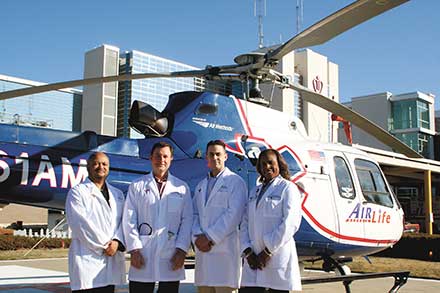Pictured Above Top is Joan Glancy Clinic in the 1940s. Today Gwinnett Medical Center – Duluth.. Today, the Glancy campus includes the Center for Surgical Weight Management, Glancy Rehabilitation and the Diabetes & Nutrition Education Center.
With three campuses, 4,500 employees and affiliated 800 physicians, the Gwinnett Medical Center (GMC) serves more than 400,000 people each year with a variety of health care services. Cardiovascular services, joint replacement, robotic surgery, cancer care and exemplary women’s services are but a few of the offerings that GMC continues to grow and improve.
Owned by the Gwinnett Hospital Authority, leased to the Gwinnett Hospital System which is a non-profit organization and run by the Gwinnett Hospital System Board of Directors, GMC has an interesting history that began after World War II when the Joan Glancy Memorial Hospital was established in Duluth. Named after the child of its benefactor, the hospital opened first as a clinic in 1941 in a three-room frame cottage. The hospital opened in 1944 followed by Hutchins Memorial in 1948 in the town of Buford.
With a population of 30,000 but only 44 hospital beds, elected officials realized the need to better serve its populace with more and better medical facilities. In order to facilitate the needs, the Gwinnett Hospital Authority was established in 1957. The Authority saw the need to increase the number of beds and developed a long-range plan to build a hospital system with one centrally located hospital with 200 beds and three strategically located hospitals with 70 to 75 beds.
Federal financial help from the Hill/Burton Act which loaned money to communities to build hospitals, allowed a new hospital, Button Gwinnett to be built in Lawrenceville on Scenic Highway. With 35 beds it was the first hospital of the Authority’s long-range plan to be completed.
The plan was further enhanced in 1966 when Button Gwinnett Hospital expanded to 74 beds and the new Buford General Hospital with 40 beds opened, replacing Hutchins Memorial which was closed.
The county now had three hospitals but still no larger, central facility. With the county growing by leaps and bounds, the need for more beds and better medical facilities also grew. Finally, in 1976 federal funding became available and plans for a new central hospital were approved by the Authority and in 1986 the Gwinnett Medical Center opened with 190 beds at a cost of $36 million.
Wayne Sikes, former Chair of the Gwinnett Health System Board of Directors and member of the Gwinnett Hospital Authority since 1989 recalls that the Authority was pressured to build a new hospital because Snellville had just built a new private center.
“People with insurance were going there and our county system was getting those without insurance. The Authority decided to build new hospital to compete and treat those with and without insurance.
“The first attempt to issue bonds paid by the taxpayers was a failure. It was former Gwinnett Commission Chairwoman/Mayor Emeritus of Norcross Lillian Webb and the late Andy Andrews, Authority members at the time, who determined ‘the county had to have a new hospital or we will die.’”
Sikes said to build the new hospital the Authority borrowed $36 million through Revenue Anticipation Certificates in which the government credits money back when the hospital treats people with no resources, such as insurance.
“An interesting point is that 20 years later we were serving more indigent and giving away more than $36M in services,” Sikes pointed out. “But that is what a community hospital is there for – to serve everyone. GMC takes care of everybody.”
When Sikes was appointed to the Authority in 1989 Gwinnett Medical Center (now Gwinnett Medical Center in Lawrenceville) had just the original tower and Sikes recalls that the building and services were very basic, offering general, medical, surgical and diagnostic services and a 24-hour emergency room.
“After GMC was built all the hospitals – GMC, Joan Glancy and Buford General – came together under the Gwinnett Hospital Authority,” Sikes explained. Button Gwinnett Hospital was closed and became SummitRidge, a 76-bed behavorial health inpatient facility. SummitRidge was sold in 2008. “We felt that it should be owned and run by people in the business because they were more knowledgeable,” Sikes said.
Growth continued with the opening in 1991 of the Gwinnett Women’s Pavilion which provides maternity and newborn services.
Through the years GMC has continued to grow and expand services to the community. The opening of the Gwinnett Extended Care Center (GECC) on the Lawrenceville campus, which provides care for patients who are in between inpatient hospital care and independent living, as well as, traditional nursing home care, the new Gwinnett Medical Center – Duluth, which replaced Joan Glancy Hospital, which in turn, became a 30-bed inpatient physical rehabilitation program under GMC-Duluth – all have contributed to the spectrum of healthcare in Gwinnett.
History was truly in the making in 2009 when the State of Georgia approved GMC’s certificate to have an open heart surgery center and in 2012 the Strickland Heart Center opened. No longer did Gwinnett citizens needing cardiac care need to travel to Atlanta.
Just as from a tiny acorn grows the oak, from the tiny Joan Glancy clinic to the cutting edge multifaceted system it is today, GMC has grown to become one of the nation’s top 100 hospital systems serving hundreds daily and saving lives through the latest in technology, medical procedures and treatments.
For more information on GMC go to http://www.gwinnettmedicalcenter.org.
Read more
GMC is transforming healthcare

GMC’s Level II Trauma Center in Lawrenceville is one of the busiest in the state. In this photo (l to r) are Romeo Massoud, M.D., Philip Cannon, M.D., Jeffrey Greenwood, M.D., and Deborah Griffiths, M.D.



